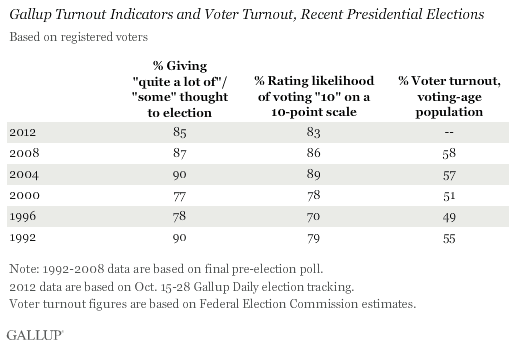PRINCETON, NJ -- Key Gallup indicators of voter turnout, collected prior to superstorm Sandy, suggest voter turnout will fall short of what it was in 2004 and 2008. U.S. registered voters report giving less thought to the election, and are less likely to rate their chance of voting as a "10" on a 10-point scale, than in 2004 and 2008, two higher-turnout elections. However, the 2012 figures are higher than in 1996 and 2000, two lower-turnout elections.

The questions are two of the seven that factor into Gallup's likely voter model. The model assesses individual respondents' likelihood of voting by asking about current voting intentions and past voting behavior. "Election thought" and the 10-point "likelihood of voting scale" are the two questions that focus on current voting intentions and show the most variation from election to election.
As the above chart indicates, in years like 1992, 2004, and 2008 when turnout was greater, more registered voters have tended to say they are giving at least some thought to the election, and to rate their likelihood of voting as high as possible. The percentages on these questions were lower in both 1996 and 2000, when proportionately fewer Americans voted.
Thus, the current data suggest turnout could fall in between the lower levels of 1996 and 2000 and the higher levels of 2004 and 2008.
The current results are based on Gallup Daily election tracking from Oct. 15-28. Voters' thought given to the election and voting intentions often increase closer to Election Day. However, superstorm Sandy has overtaken the election campaign as the dominant news event in recent days, which could in turn affect voters' attention to the campaign and voting intentions. Gallup has suspended its election tracking due to concerns about being able to adequately represent the U.S. electorate with so many in the East affected by the storm.
Additionally, the practical impact of Sandy and the storm's aftermath on voter participation this year is unclear, particularly in areas of the East and Mid-Atlantic where the effects could linger through Election Day on Nov. 6. Many voters in that area of the country who are engaged in the election and have every intention of voting may be unable to go to the polls on Election Day. Sandy could also have an effect on early voting in those states, though early voting is far less common in the East than in other parts of the country.
Implications
U.S. voters have not been quite as engaged in the 2012 election as in the two that preceded it, even before Sandy. However, their stated voting intentions and reported thought given to the election suggest turnout would likely not revert to the lower levels of 1996 and 2000. If turnout does come in lower this year -- that is, it looks more like 1996 and 2000 and less like 1992, 2004, and 2008 -- that may be another effect of Sandy in addition to flooding and widespread power outages.
Survey Methods
Results for this Gallup poll are based on telephone interviews conducted Oct. 15-28, 2012, on the Gallup Daily election tracking survey, with a random sample of 6,520 registered voters, aged 18 and older, living in all 50 U.S. states and the District of Columbia.
For results based on the total sample of registered voters, one can say with 95% confidence that the maximum margin of sampling error is ±1 percentage point.
Interviews are conducted with respondents on landline telephones and cellular phones, with interviews conducted in Spanish for respondents who are primarily Spanish-speaking. Each sample includes a minimum quota of 250 cell phone respondents and 250 landline respondents per 500 national adults, with additional minimum quotas among landline respondents by region. Landline telephone numbers are chosen at random among listed telephone numbers. Cell phone numbers are selected using random-digit-dial methods. Landline respondents are chosen at random within each household on the basis of which member had the most recent birthday.
Samples are weighted by gender, age, race, Hispanic ethnicity, education, region, adults in the household, population density, and phone status (cell phone only/landline only/both, cell phone mostly, and having an unlisted landline number). Demographic weighting targets are based on the March 2011 Current Population Survey figures for the aged 18 and older non-institutionalized population living in the U.S. All reported margins of sampling error include the computed design effects for weighting.
In addition to sampling error, question wording and practical difficulties in conducting surveys can introduce error or bias into the findings of public opinion polls.
For more details on Gallup's polling methodology, visit www.gallup.com.
